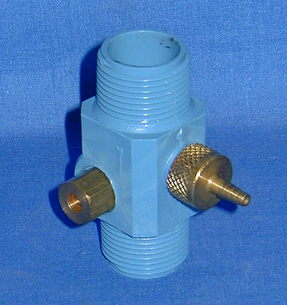Aeration--A Non-Chemical, Environment-Friendly Treatment
for Problem Contaminants in Well Water
To read this special edition on our website.
Iron and hydrogen sulfide (H2S) are common well problems that frequently occur together and often lend themselves to similar treatment. Iron corrodes appliances, ruins clothing in laundry, stops up pipes, discolors fixtures; hydrogen sulfide, or rotten egg odor, makes water unpalatable and unpleasant, blackens plumbing fixtures, and can be a health hazard when severe. Where there is iron, there is often manganese, which in very small amounts can cause black staining and odors.
The standard methods used to treat iron, hydrogen sulfide, and manganese are variations on the same three-step principle of oxidation, precipitation, and filtration. An oxidizer is added to the water, which induces precipitation of the iron, manganese and hydrogen sulfide, and the precipitated contaminant is then filtered out of the water.
A variety of filters are used to remove oxidized contaminants, but here we are concerned only with the first step, oxidation.
The Common Oxidizers
The old-standby oxidizers for years have been chemicals like chlorine and potassium permanganate. Ozone and hydrogen peroxide are more natural oxidizers that are gaining in popularity. Another common oxidizer that is being used with ever greater frequency is air.
Oxidizing with Air
Plain air is a powerful oxidizer of iron, manganese, hydrogen sulfide. It has a variety of advantages, including its low cost and its easy availability. Air adds nothing objectionable to water and leaves no undesirable by-products. Air is in plentiful supply and does not have to be transported to the treatment site.
Air can be applied to water treatment in a variety of ways. We're going to look at the most popular applications here.
Open Air Tanks and Air Stripping
Air stripping is a technique in which volatile organic compounds (VOCs) are transferred from water to air. Typically, air stripping takes place in a packed tower (known as an air stripper) or an aeration tank.
Traditional air strippers vary in height, and the height is correlated to the chemical concentration of the contaminated water. A recent innovation in air strippers is the low-profile air stripper. These units have a number of trays that are set almost horizontally. Water is cascaded over the trays to maximize air-water contact while minimizing vertical space. Because they are not so visible, they are increasingly being used for groundwater treatment.
Below is a picture of an older more "visible" stripper.
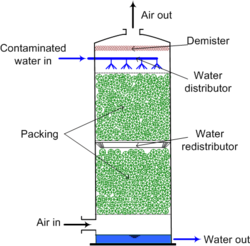 |
The “air stripper” includes a spray nozzle at the top of the tower. It sprays the water being treated over the packing (usually plastic balls) in the column. As the water descends, air is forced up through the column, stripping off the volatile compounds. Packing or baffles within the tower increase the surface area of the contaminated water that is exposed to air, thus maximizing the intensity of the treatment. A sump at the bottom of the tower collects decontaminated water. Auxiliary equipment may include an air heater to improve removal efficiency and air emission “scrubbers.” |
Strippers are used most often to rid water of volatile organics (VOCs) and gasses like methane and radon. Methane and radon are often "aerated" by simply allowing the water to stand in an open tank.
For residential treatment of iron, manganese, and hydrogen sulfide, compact closed-tank aeration units are used. Below are some examples.
The Venturi System
The simplest of the closed-tank systems is a passive aeration system that requires no outside power. It pulls air into the water line by means of an induction device called a venturi. The venturi (sometimes called a "Micronizer" or an educer) is installed in the water line prior to the well's pressure tank. As water is forced through the venturi while the pressure tank is filling, air is sucked into the water line. The aerated water then enters a small treatment tank where the air is mixed thoroughly with the water and excess air is vented to the atmosphere. The water then passes to a filter, which removes the oxidized contaminants.
The Venturi above draws air in through the barbed nipple at right and mixes it directly into the water stream.
Here's what the whole "venturi" setup looks like. (The filter, a necessary part of the system, is not in the picture.)
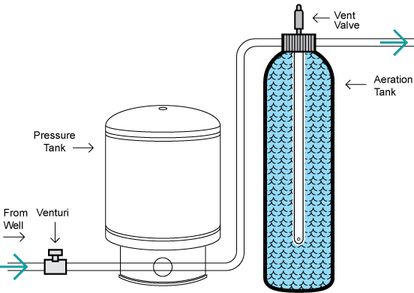 |
The venturi system shown above uses no power. When the well's pump comes on in response to low pressure in the pressure tank, air is sucked into the main water line through the small venturi valve just before the pressure tank. The air is mixed with the water inside the aeration tank at right. Some of the air is vented to the atmosphere through the small vent valve on top of the aeration tank. After a short residence in the tank, the aerated water continues to the next treatment stage via the water pipe at right. |
The main advantages of the venturi system are its low cost, its economy of operation, and its simplicity. The main disadvantage is that the venturi valve itself restricts water flow considerably. The venturi works by funneling the entire water stream through a very small hole inside the valve in order to create the pressure differential required to pull air into the water line. This restricts water flow and often makes it difficult to size the filters which follow the unit, since iron filters often require significant backwash volume. Consequently, venturi systems are most often sold as "one size fits all" units that use a standard 8" X 44" aeration tank, relatively easy to backwash filter media, and filter tanks no larger than 10" X 54".
Air Pump Systems
A more aggressive approach to aeration, the air pump system uses a small compressor to pack air into a special aeration tank. This system normally has much more air turnover and therefore requires a more complex venting system than the venturi system.
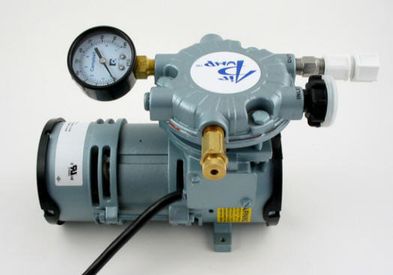 |
A small, quiet, efficient air compressor the size of a football is the heart of the pump-driven aeration system. It injects air directly into a treatment tank and maintains a pressurized pocket of air in the upper portion of the tank. Water entering the tank sprays through a pocket of compressed air for rapid oxidation of contaminants. |
Here's what the whole setup [without the filter(s) ] looks like:
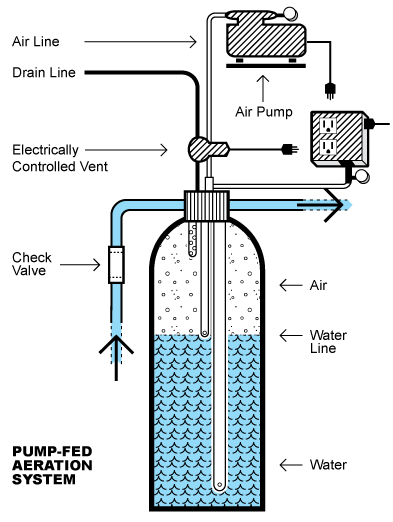 |
The illustration above of a typical residential aeration system shows one of the ways that air can be introduced into water to treat iron and hydrogen sulfide. It features a small air compressor and a special tank in which treatment takes place. The system above has an electrically controlled vent system to vent some of the hydrogen sulfide gas to the atmosphere, but especially to provide for a turnover of air in the tank.The air pump delivers air into the tank and a pocket of compressed air forms in roughly the top third of the tank. As water being treated enters the tank through the pipe at left, it hits a baffle or diffuser (of the three pipes attached to the vent head, it's the short pipe on the left) and sprays down through the pocket of compressed air. The water is further aerated inside the tank before it leaves by way of the long tube (called a riser) which picks it up at the bottom of the tank and sends it out through the pipe at right. The mid-length tube in the center is the vent tube. It controls the depth of the air pocket.When the air pump is activated, the solenoid valve opens at the same time and an air/water mixture exits the tank via the middle tube and the drain line.The pump and vent are controlled by the same electrical circuit so that when the pump is running, the vent is open and air is being exchanged. When the pump turns off, the vent closes and the compressed air pocket is maintained.The electrical circuit that turns the pump/vent system off and on can be controlled in a variety of ways. The most common is by wiring them into the well's own pump circuit, so that the aeration system is activated when the well pump is running. Another way--and this is shown in the diagram--is with a specially designed control that monitors the pressure inside the aeration tank and activates the pump/vent according to aeration tank pressure. A third popular activation system is a flow switch, which turns the pump/vent system on when water is flowing to the home. |
The air pump setup above does not restrict water flow (as does the venturi system) but it uses a small amount of electricity to run the pump and power the solenoid vent valve. Its initial cost is more than the venturi system. It is a reliable system and little upkeep is normally needed. Any system, it should be noted, that treats iron needs upkeep because of problems caused by the formation of iron deposits within the system itself. Air pump units are no exception.
The strength of the air pump system is that air is a very rapid oxidizer, so much less retention time is needed as compared with chlorine. Normally, the aeration tank itself provides plenty of holding time for air to do its work. And larger air tanks can be used if more contact time is needed.
Single Tank Systems
Yet another style of aerator that has been around for some time is the one- tank system in which aeration and filtration take place in a single tank. This style is usually marketed as single package without options.
The single tank unit
maintains an air pocket in the top of the tank. As the service water passes through the air
pocket, iron and H2S
are oxidized and the oxidized contaminant is
then caught by the filter in the bottom portion of the tank.
Air is
introduced by venturi draw, but not by an added venturi unit as with the
simpler system above.
In this type, the unit is controlled by a
modified water softener valve which is made to draw air into the tank
during the "brine draw" phase of its regeneration cycle.
With this type system manufacturers usually claim effectiveness against six to eight ppm of hydrogen sulfide and 8 or so parts per million iron. Different media are used in the tank depending upon if iron or hydrogen sulfide is the main targeted contaminant.
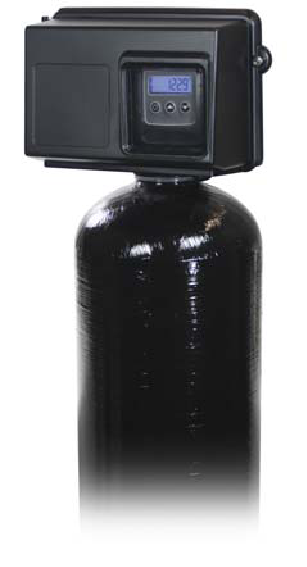 |
Pictured above is the Nelsen Corporation's "Eliminator" single tank unit. It features a standard mineral tank with iron or sulfide reduction medium. It is controlled by a modified Fleck 2510 SXT softener control. There are several brands of single tank units, all similar in design. |
Single tank systems are relatively expensive because of the sophisticated control head and they lack versatility. However, they can provide excellent, trouble-free service, and installation is simple.
Pure Water Products Aeration Offerings
We've been selling aeration devices since the early 1990s. We currently feature our slightly modified version of a national brand called AerMax. It's a closed tank system with a small air pump. We stock complete systems, accompanying filters, and all parts. We also offer optional add-ons to the AerMax like the "Air Head" pressure control system and a "double aeration" feature for enhanced treatment of hydrogen sulfide.
We have an air pump parts page, offer repair kits and even some reconditioned air pumps. We stock the less expensive "venturi" systems and parts for them, although we don't have them on our main website.
In the twenty years we've sold aeration devices, we've never marketed them as "green" products. When you think of it, though, what could be "greener" than a treatment system that uses a renewable resource, requires only minimal energy, keeps chemicals like chlorine and potassium permanganate out the environment, and has no negative environmental impact at the point of use?
Where to Find Aeration Products on our Websites AerMax, our main aeration product, is featured on our main website. This is an information-packed page with lots of discussion of iron/sulfide treatment in general. Air Pump Parts. Also on our main web page, we have what we feel may be the only parts page on the internet for residential aeration products. It features mainly the parts for our Aermax systems, but others are included as well. How Aeration Systems Work, a more detailed explanation of venturi and air pump systems, is located in the Occasional's "How It Works" series. Simple Aeration Supplies, on the Occasional's site, lists inexpensive parts and complete venturi systems that aren't on our main website. (We stock these parts, but they must be ordered phone at this time.) More information from our main website: Iron Removal--A World Without Rules, by Scott Harmon. Strippers Play a Role in POE Water Treatment, by Bruce Lamarre. A discussion of how to remove radon with an air stripper. An Irrigation Well With Lots of Iron. A PWP staff article about iron removal with an AerMax unit from a high iron irrigation well. And, as always, there is much, much more. Go to the Google search bar on any page of our main website and type in "aeration." |
Pure Water Products
940 382 3814
